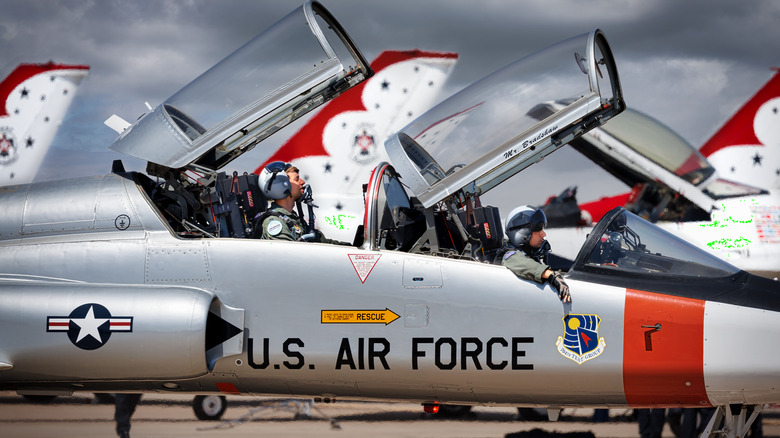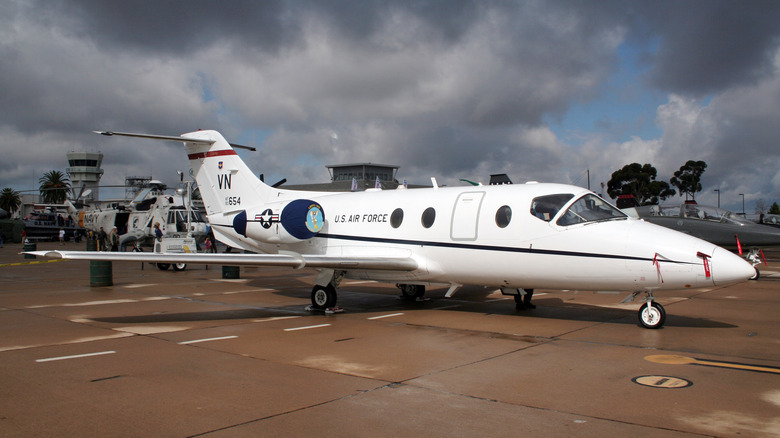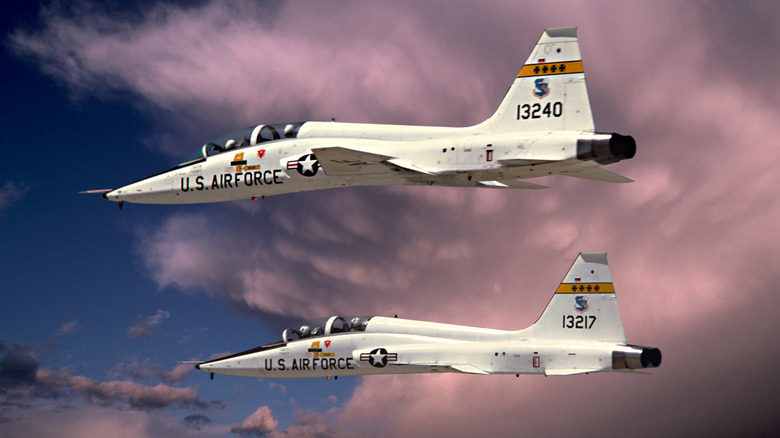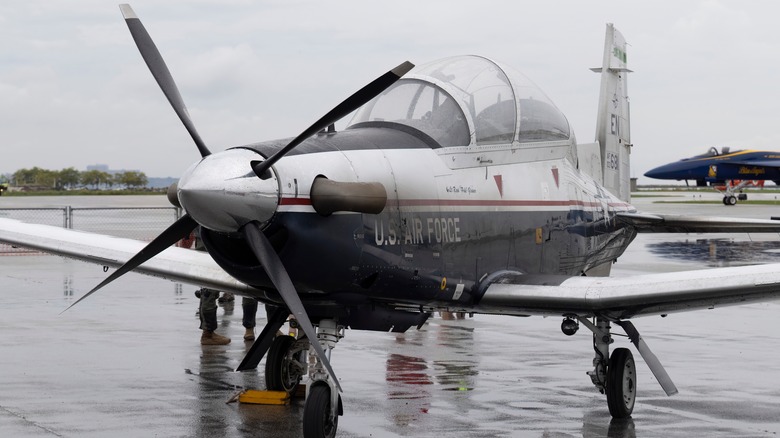What Jets Does The US Air Force Use For Training?
It might come as a surprise to some that F-22 Raptor pilots don't go through flight school training in the Raptor. The same is true with the F-15 Eagle and F-16 Falcon. When you learn to swim, you don't dive right into the deep end. No, you start at the shallow end and work your way down until you have the basics. Whether your aspirations are to fly a fighter jet, a bomber, or a tanker, you're going to train in two out of three aircraft. All Joint Primary Pilot Training (JPPT) students on track to pilot an Air Force bomber-fighter, airlift-tanker, or a helicopter, will find themselves starting out in a T-6A Texan II. The T-1A Jayhawk, on the other hand, is there for students undergoing advanced training to fly an airlift or tanker.
Students hoping to get behind the stick of one of the Air Force's fifth-generation or its upgraded fourth-gen fighters will move on from the T-6A Texan II and train in a T-38 Talon. It's the only turbojet aircraft amongst the three trainers, which makes sense since those are the type of powerplants fighter jets use. Even B-1B Lancer pilots first train in the Talon. These planes give trainees the closest representation to the type of planes they'll be flying once they're placed with their squadrons.
The T-1A Jayhawk is a militarized light business jet
Once Air Force trainees who have identified airlifts and tankers as their piloting goal have moved onto specialized training, they get to sit in the cockpit of the more spacious T-1A Jayhawk. This twin-engine Beechcraft is the military's version of the Beech 400A, providing similar flight characteristics to the larger planes in the military. This militarized version comes with the addition of an extra fuselage fuel tank, giving it a maximum range of 2,900 nautical miles.
Unlike pilots in the T-38 Talon, the Jayhawk isn't training anyone to fly at supersonic speeds or perform combat maneuvers. Its two engines are Pratt and Whitney JT15D-5B turbofans. This plane is designed for subsonic (538 miles per hour) flights that are significantly smoother and less erratic than you'd expect from a fighter jet. Additionally, this version of the Beech 400A can better withstand turbulence and bird strikes than its civilian counterpart.
The Navy, Marine Corps, and some foreign agencies have been known to use it to support advanced navigator training. The cockpit accommodates three crew members, including the pilot, co-pilot, and an instructor, with two seats side-by-side and a third directly behind the instructor's seat. Even behind the pilot trainee and instructor, the third seat still provides maximum visibility. The Air Force has 178 Jayhawks in its inventory and has been gradually upgrading their avionics since 2018, with the first upgraded plane flying in 2019.
Fighter pilots in training are assigned to the T-38 Talon
The T-38 Talon comes from Northrop's assembly line. It took its maiden flight in 1959 before the Air Force ordered more than 1,100 of them, and it has been training future fighter pilots and bombers since 1961. It's powered by a pair of General Electric J85-GE-5 turbojet engines with afterburners. Without engaging the afterburners, each engine can produce 2,050 pounds of thrust. If the pilot wants that extra little oomph, each engine will kick out 2,900 pounds instead. In 2002, the USAF's fleet of Talons was part of a Propulsion Modernization Program (PMP) that extended its lifespan and improved "airframe and engine deficiencies related to safety, performance, reliability and maintainability."
Talons with this modification have engines that can produce 2,200 pounds of dry thrust or 3,300 pounds with afterburners, giving them 19% more thrust. PMP or not, the T-38 has always been a supersonic jet, achieving Mach 1.08 (or 812 mph). It's nowhere near the velocity of any of the Air Force's frontline strike fighters, but it gives trainees a decent idea what to expect once they're in the major leagues. Not to mention, the Talon doesn't need much of a runway to take off – 2,300 feet will do just fine — and it can zip up to 30,000 feet in a minute.
Air Force trainees aren't the only ones who get to practice in a T-38. NATO pilots travel to Sheppard Air Force Base in Texas for the Euro-NATO Joint Jet Pilot Training Program. NASA has also utilized this training jet for various tasks, including observing landing space shuttles.
All trainees start with the T-6A Texan II
When USAF trainees start their flight training, they start in the single-engine T-6A Texan II. Sure, it resembles an old prop plane you'd see in a World War II history book, but it's used to teach the basic flying skills to both Air force and Navy pilots before they go onto their specialized training. The Texan II has a Pratt & Whitney Canada PT6A-68 turbo-prop engine that can produce 1,100 horsepower. It might not have the impressive speed of something with an afterburner — only 320 miles per hour — but its thrust-to-weight ratio isn't anything to scoff at. It can climb to 18,000 feet in just under six minutes at a rate of 3,100 feet per minute and reach a maximum of 31,000 feet.
The Texan's cockpit seats two in tandem: one for the trainee and the other for the instructor. The Air Force's trainer comes with a pressurized cockpit and an ejection seat, as well as an anti-G system and advanced avionics. The big difference between the Air Force's and Navy's version is the Aviation Life Support System (ALSS) gear that Navy trainees need for over-water training.



